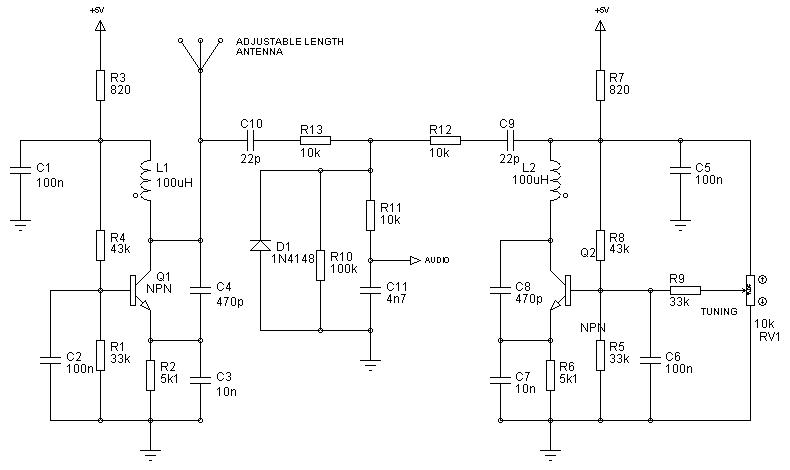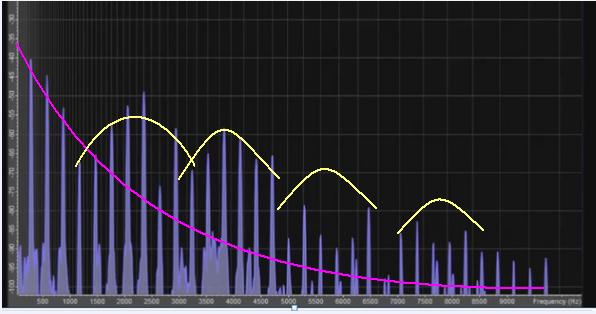"So, you couldn't help me further with the circuit? (it's just I need to know how to proceed further with the presentation)" - Alex
I cannot help you to get your present circuit to work, but there is a slight chance you could use those components to make something that changes its pitch as you move your hand..
"But what I want to know is, how the sound (lets say a sine wave), coming from a theremin, is filtered in real time. Can it make the theremin sound like the violin in real time?"
First - if you filter a sine wave, the most you can do is reduce (or if the filter has gain, increase) its amplitude - you cannot modify its harmonics (overtone) levels, because a sine wave has no harmonics.
With subtractive synthesis, one starts with a waveform rich in harmonics, and removes (or reduces or increases) the harmonics you want to alter.
As to "Can it make the theremin sound like the violin in real time?" - my first post here answered that question I think, and the SOS articles elaborate - IMO the answer is both "yes" and "no" - One well never get a good emulation of a good violin played by a master, even by a master thereminist with a good instrument - Acoustic instruments just have too many factors which make each unique - even "physical modeling" cannot produce a convincing Strad (or even a specific cheap violin).
All that can be done is to get an proximately "right" tone and play the "emulating instrument" as closely to the form of the 'original' instrument - if these conditions are met (or reasonably good enough) it may fool a non-critical listener.
But this brings me to a question perhaps you should raise in your presentation... Is there REALLY any point in trying to emulate an acoustic instrument accurately on a theremin? The obsession with "emulation" arose, I believe, at a time when peoples imaginations were limited to the sounds from available acoustic instruments - those days are passed -
Ok - the idea of a "universal" instrument that can replace acoustic ones is tempting - and can almost be realized IF one isn't trying to exactly copy another instrument.. But someone who REALLY wants to play and master a violin (and I am talking about REALLY wanting violin - not just a violin-like sound) should get a violin , not a theremin!
Bowed instruments are generally more difficult to emulate because of the control the player has over pitch and dynamics - For this reason the theremin is better suited to emulating the violin than say a keyboard.. But after many decades of trying to emulate the sound of an acoustic grand, and with millions of £ spent on R+D, we are only getting close to a reasonable replication now.. There has been no such effort devoted to using the theremin to emulate bowed instruments (IMO for good reason ;-) and we are millions of miles from getting to the point that a theremin could realistically perform such emulation for a violin IMO, and I would bet it wont ever happen.
If the sound and playing fits the music, isn't this all that matters? If the listener thinks "this sounds like a violin" or "this sounds like a theremin" does it matter? - surely all that matters is whether its enjoyable / musical / expressive.. If its not, if it needs a real violin sound for whatever reason, then something is "wrong" - and this "wrongness" probably wont be primarily due to the sound from the instrument, it will be due to the playing or use of a theremin for that part.
To me, the beauty of electronic instruments is the ability to 'sculpt' the sound to suit the part - Lev Theremin was, I think, not thinking this way with the theremin - And rather than accepting their place as synthesizers, theremins have retained limited tone and synthesis control built into them.. Its a bit like if Bob Moog had simply picked a few presets and given user control of say decay time and filter cut-off.. this would have limited the potential - Only a fool would attempt to emulate a grand piano on a Mini Moog - but thats not what musicians want to do with it! - Theremins "should" be recognized as monophonic synthesizers, its only the fact that they have been artificially "disabled" that has caused them to be seen as something other than synthesisers. (I suspect that one reason modern theremins have retained this limited adjustment of tone is because its cheaper than bringing the theremin to "standard" and people seem to accept these limitations so there is no motivation for change)
If they had not been "disabled" then the question "Can it make the theremin sound like the violin in real time?" Would be similar to asking whether a Mini-Moog and a ribbon controller could sound like a violin.. and the answer would be that with the ribbon controller it was better suited, but still not able to do a truly realistic 'emulation'.
Fred.
Have you seen this http://www.thereminworld.com/Article/14388/new-theremin-cello-video-online ?
Doesnt sound like a Cello to me! But thats OK!




